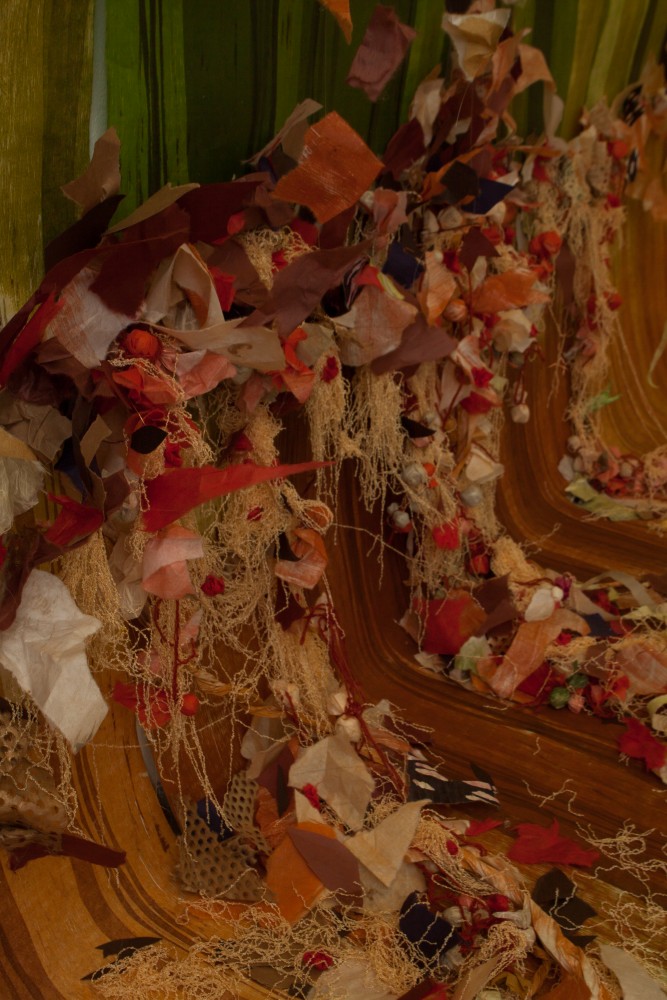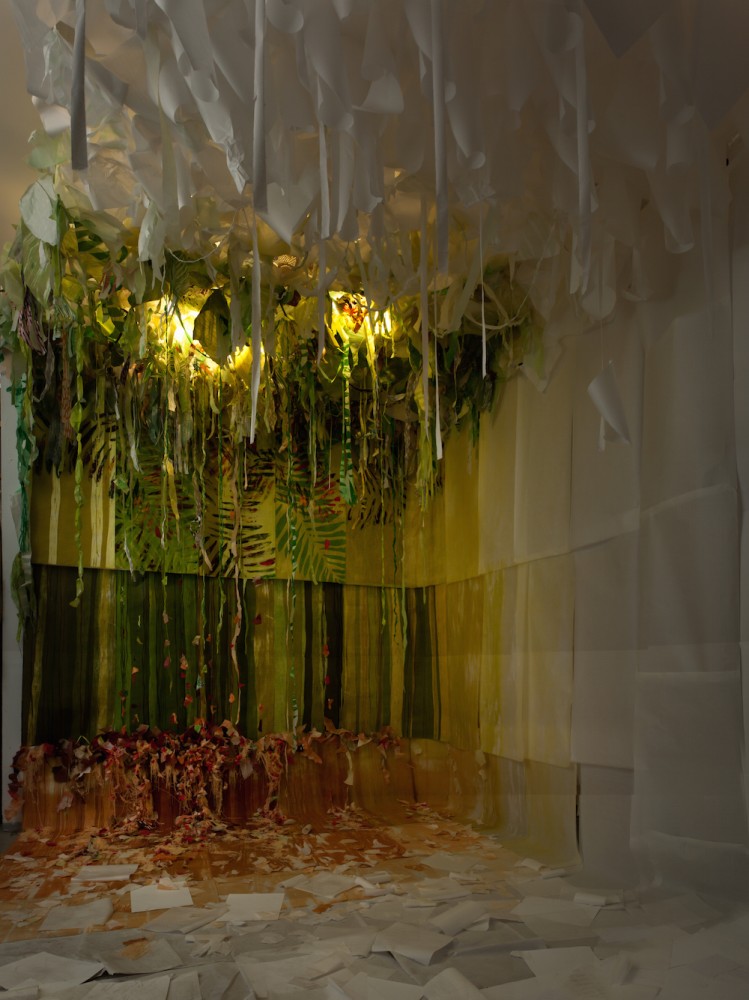A printmaker, a rainforest ecologist, and a biologist walk into an art studio. The three colleagues share a goal: to communicate the complexities of a tropical forest ecosystem in a way that is both visually striking and scientifically accurate.
Kate Aitchison, the partnership's artistic muscle, is a graduate student at the Rhode Island School of Design. Aitchinson has spent the last 8 summers working as a river guide and experiential educator focused on the Grand Canyon and the Colorado Plateau. "Those experiences have heavily informed my work as an artist," she says. "[They have] inspired me to create work that is connected to science and the environment as a way to connect viewers back to place and the importance of the natural world."
Last winter, reflecting on her interest in environmental stewardship and land use, Aitchison reached out to a group of environmental scientists at Brown in search of collaborators for an independent student assignment. Brooke Osborne, a PhD student in Ecology & Evolutionary Biology (EEB) and graduate student at the Institute at Brown for Environment and Society, gladly answered the call along with fellow EEB graduate student Robert Lamb, who helped to conceptualize the project.

Osborne, who studies nutrient cycling in the rainforests of Costa Rica's Osa Peninsula, has always been interested in creative methods of science communication. "Not only in terms of giving public talks or creating posters that are easily accessible," she explains, "but genuinely alternative ways to communicate science."
Osborne's research centers on tracing the path of key nutrients such as nitrogen and phosphorus from the ceiling of a tropical rainforest ecosystem to the trenches. This work requires her to alternate between examining remotely-sensed maps of nitrogen in canopy leaves and traveling to Costa Rica to measure the nutrient content of decomposing plant material that litters the forest floor. By quantifying the circulation of nutrients between these two regions, Osborne can better understand the way that such essential chemicals become incorporated into the biomass of other organisms.
 Aitchison's installation, a room-sized conceptual replica of a tropical forest ecosystem made entirely from her own printed paper, includes representations of both the canopy, a dense ceiling penetrated solely by feeble threads of light, and the damp, dark, verdant region below. Toward the bottom of the exhibit is a deep orange border, a stand-in for the rust-colored soil that separates the lush, visible part of the rainforest and its floor from the relatively nutrient-poor subterranean world. Peppered throughout this region are tiny red balls that represent root nodules, which house colonies of bacteria that excel at harvesting nitrogen from the air. Not all trees can accommodate this kind of mutualism, however, and so those that do have a distinct growth advantage. (They also make especially prized neighbors!)
Aitchison's installation, a room-sized conceptual replica of a tropical forest ecosystem made entirely from her own printed paper, includes representations of both the canopy, a dense ceiling penetrated solely by feeble threads of light, and the damp, dark, verdant region below. Toward the bottom of the exhibit is a deep orange border, a stand-in for the rust-colored soil that separates the lush, visible part of the rainforest and its floor from the relatively nutrient-poor subterranean world. Peppered throughout this region are tiny red balls that represent root nodules, which house colonies of bacteria that excel at harvesting nitrogen from the air. Not all trees can accommodate this kind of mutualism, however, and so those that do have a distinct growth advantage. (They also make especially prized neighbors!)
Juxtaposed to all of this complexity, at the opposite end of the exhibit, stands an ersatz rainforest that is identical in every way except one: here, each element has been thoroughly bleached of all color, texture, and detail. The observer is urged to contemplate the stark divergence between the intricate world on his or her left with the barren wasteland of white on his or her right. Aitchison, Osborne, and Lamb hope that this dramatic contrast will convey the devastation that deforestation inflicts on the biosphere.
 "It's been incredibly exciting and provocative to watch how Kate assimilates and transforms our empirical research into this vibrant, dynamic, and engrossing art form that communicates our ideas and scientific insight in a completely different medium," remarks Lamb.
"It's been incredibly exciting and provocative to watch how Kate assimilates and transforms our empirical research into this vibrant, dynamic, and engrossing art form that communicates our ideas and scientific insight in a completely different medium," remarks Lamb.
Osborne adds that you don't have to be a scientist in order to understand the basic relationships that Aitchison's artwork attempts to illustrate. "You can tell from how dense and layered and colorful the exhibit is, whether you know about the science or not, that there are many complex mechanisms at work in intact tropical forests," she says.
"When you start to remove elements of that complexity, the dynamics of the system are altered," she explains, reflecting on the bleakness of the right half of the installation.
"In the extreme case of deforestation, for example, an important change is that essential nutrients like nitrogen and phosphorus are no longer being assimilated and cycled by trees. They are being lost from the system," Osborne continues. "And certainly the major, most obvious difference is the loss of stored carbon that comes with the removal of forest biomass."
"It's not insignificant at all, the amount of C that these rainforests store and keep out of the atmosphere," she emphasizes.
Ultimately, Osborne and Aitchison hope to submit their project to universities or traveling art and science exhibits. "The goal is to reach a broader audience, and to reach them within a few minutes as they walk by and interact with Kate's installation," explains Osborne.
"I hope this project communicates a sense of how fragile and complex these ecosystems are, and what is lost when they are altered or destroyed," she concludes. "And I hope it also gives the viewers a sense of how inherently special and interesting they are, as a place to go, or to have some vested interest in protecting or conserving."
"I hope viewers are inspired to reconnect with their own natural environments and think about the ways in which we use different environments for our own well being," adds Aitchinson. "I want to give people an entry point back into the environment in a way that's less abrasive and jarring than a lot of the new we receive today."
Osborne and Aitchinson are currently collaborating on a new project with Robert Lamb and his adviser, Professor of Ecology & Evolutionary Biology Jon Witman. The team's forthcoming installation will center on oceans, drawing from Lamb's and Witman's work in the Galapagos.
The rainforest installation is not yet open for public viewing. If you are interested in viewing the exhibit, please email environment@brown.edu for updates regarding where and when it will be shown.